 The final April poll is out in Slovakia and because it is “Median” it is more or less what we might expect, which is to say that for the parties whose numbers are most interesting, Median’s numbers are utterly unreliable. Actually in technical social science terms they are quite reliable in that they “measure the same way each time” and almost certainly invalid in that, at least from the perspective of somebody who is interested in how people will actually vote they are almost assuredly not a good “approximation to the truth or falsity of a given inference, proposition or conclusion” (For more on the differences, see http://www.socialresearchmethods.net/tutorial/Colosi/lcolosi2.htm). In other words–and this is much the fault of the Slovak media as it is of Median–DON’T RUN STORIES ABOUT WHO WILL GET INTO PARLIAMENT OR NOT USING MEDIAN DATA.
The final April poll is out in Slovakia and because it is “Median” it is more or less what we might expect, which is to say that for the parties whose numbers are most interesting, Median’s numbers are utterly unreliable. Actually in technical social science terms they are quite reliable in that they “measure the same way each time” and almost certainly invalid in that, at least from the perspective of somebody who is interested in how people will actually vote they are almost assuredly not a good “approximation to the truth or falsity of a given inference, proposition or conclusion” (For more on the differences, see http://www.socialresearchmethods.net/tutorial/Colosi/lcolosi2.htm). In other words–and this is much the fault of the Slovak media as it is of Median–DON’T RUN STORIES ABOUT WHO WILL GET INTO PARLIAMENT OR NOT USING MEDIAN DATA.
(For a prime example, see SME prieskum-medianu-nepustil-do-parlamentu-smk-a-most-hid.html, though the headline does at least specify that the poll is from Median, which is a warning to more informed readers. Slightly less irresponsible, but rather odd is the TA3 headline, PRIESKUM: Keby boli voľby v apríli, vyhral by ich Smer-SD which emphasizes that Smer “would win” despite the fact that this is the one thing everybody does know and that the Median data for this month actually shows the largest single drop in support for Smer of any Median poll I can find.)
So what can we make of Median’s numbers. In the spirit of Stephen Stucker, we can still make something. Median’s trendlines are not usually out of line with the rest of the parties. So here’s what we learn.
 In Median’s poll Smer shows an enormous drop–almost six points. This comes after two months of Smer numbers in Median that were unusually high and bucked the trendline of the other polls, so this is probably simply a return closer to the norm for Median on Smer and brings it in line with the other polls, though it is worth noting that Median always polls high for Smer (with the exception of only two months in the last year it has produced the highest numbers for Smer, usually between 3 and 4 points above the average of the other three polls). So Median confirms Smer’s drop but doesn’t tell us how far, though around 36 or 37 looks like a good current guess.
In Median’s poll Smer shows an enormous drop–almost six points. This comes after two months of Smer numbers in Median that were unusually high and bucked the trendline of the other polls, so this is probably simply a return closer to the norm for Median on Smer and brings it in line with the other polls, though it is worth noting that Median always polls high for Smer (with the exception of only two months in the last year it has produced the highest numbers for Smer, usually between 3 and 4 points above the average of the other three polls). So Median confirms Smer’s drop but doesn’t tell us how far, though around 36 or 37 looks like a good current guess.
 SNS shows a big rise in Median’s numbers, one that pulls it back to January levels. The curve is almost exactly the same–though a bit higher–as that of FOCUS, suggesting that the FOCUS number is more than just statistical noise and that SNS may have actually benefitted from the Fidesz victory in Hungary. Only Polis showed no SNS bounce in April and so we can probably take the bounce seriously and perhaps move SNS slightly higher in its probability of passing the threshold, though its long-term trend is still resolutely negative.
SNS shows a big rise in Median’s numbers, one that pulls it back to January levels. The curve is almost exactly the same–though a bit higher–as that of FOCUS, suggesting that the FOCUS number is more than just statistical noise and that SNS may have actually benefitted from the Fidesz victory in Hungary. Only Polis showed no SNS bounce in April and so we can probably take the bounce seriously and perhaps move SNS slightly higher in its probability of passing the threshold, though its long-term trend is still resolutely negative.
 Median is the only poll to give HZDS a bounce in April–the other three show stability or a slight drop. In this case it may be the Median trend that is out of line. As with Smer and SNS, Median consiste
Median is the only poll to give HZDS a bounce in April–the other three show stability or a slight drop. In this case it may be the Median trend that is out of line. As with Smer and SNS, Median consiste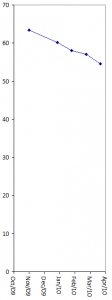 ntly polls high for HZDS and so its claims on all three of these need to be discounted a bit.
ntly polls high for HZDS and so its claims on all three of these need to be discounted a bit.
Current coalition parties overall. It is notable that even though Median tends to poll high for the coalition parties, and does so again this month, the overall trend (small graph at the right) shows an unbroken drop in total coalition preferences over the last 5 months by about 9 points overall (A disclaimer: it matters where you begin your trendine. Carry this graph back two months and it appears that January was actually an unusually high peak compared to the months before or after. But carry it back 6 months and the trend of decline re-emerges quite distinctly.)
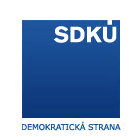 For SDKU the situation is muddled. Median polls very high for SDKU this month, but it does not always do so, suggesting that the party may have shown an increase. The evidence from the other polls is mixed: Polis also shows an increase, though not as big as the one in Median; MVK and FOCUS show slight decreases. This is one party without clear trends at the moment. It appears to be holding steady between 13 and 14.
For SDKU the situation is muddled. Median polls very high for SDKU this month, but it does not always do so, suggesting that the party may have shown an increase. The evidence from the other polls is mixed: Polis also shows an increase, though not as big as the one in Median; MVK and FOCUS show slight decreases. This is one party without clear trends at the moment. It appears to be holding steady between 13 and 14.
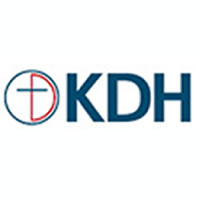 Like both MVK and Polis, Median shows a drop for KDH but from the highest level the party has ever received in a Median poll. FOCUS also showed a drop for KDH (but from a much lower baseline). Here we have significant disagreement, with FOCUS pulling the lower end and MVK near the higher with the two less established polls both showing higher. It is hard to say what this means. I will have to think about it.
Like both MVK and Polis, Median shows a drop for KDH but from the highest level the party has ever received in a Median poll. FOCUS also showed a drop for KDH (but from a much lower baseline). Here we have significant disagreement, with FOCUS pulling the lower end and MVK near the higher with the two less established polls both showing higher. It is hard to say what this means. I will have to think about it.
 This is the first Median poll to show SaS above the 5% threshold, but Median has consistently polled very low for SaS (as do all new and small parties), and what is important here is that the party shows the same almost unbroken upward trend and degree of increase in Median as in every other major poll. The party will fall back some degree when voters are in the booth, but it is hard to imagine it falling so far short that it misses the threshold.
This is the first Median poll to show SaS above the 5% threshold, but Median has consistently polled very low for SaS (as do all new and small parties), and what is important here is that the party shows the same almost unbroken upward trend and degree of increase in Median as in every other major poll. The party will fall back some degree when voters are in the booth, but it is hard to imagine it falling so far short that it misses the threshold.
The overall rise for the “right” parties is almost perfectly reciprocal to the decline of the coalition, a steady increase of 6 points since November and more from the summer of 2009. This conforms quite well to the findings of every other poll.
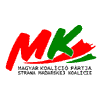
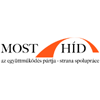 Median has a big Hungarian problem. About 11% of Slovakia’s population is Hungarian and past elections show that the Hungarian parties/coalitions together receive about the same percentage of the vote. Yet only three times in the last year has Median’s total of preferences for Hungarian parties exceeded 8% and five times (including this month) it has been below 7% (this month the two sum to 6%). This suggests a major problem with Median’s methodology or its network or both and so it is hard to give credit to its numbers for Hungarian parties or its trends. For the record this month shows a slight drop for MKP-SMK and a slight increase for Most-Hid but these likely mean little and they certainly do not merit the SME headline mentioned above.
Median has a big Hungarian problem. About 11% of Slovakia’s population is Hungarian and past elections show that the Hungarian parties/coalitions together receive about the same percentage of the vote. Yet only three times in the last year has Median’s total of preferences for Hungarian parties exceeded 8% and five times (including this month) it has been below 7% (this month the two sum to 6%). This suggests a major problem with Median’s methodology or its network or both and so it is hard to give credit to its numbers for Hungarian parties or its trends. For the record this month shows a slight drop for MKP-SMK and a slight increase for Most-Hid but these likely mean little and they certainly do not merit the SME headline mentioned above.
From my college era I remember a slogan (likely propagated by beer companies to prevent excesses that would hurt their PR and inspire anti-drinking legislation), “If you must drink, drink wisely.” A note to SME (and Pravda and TA3 and all the others:
If you must cite Median, cite Median wisely.


















 I know Slovakia’s journalists are overtaxed with all that is required of them, but there are things they could do to make things better without too much extra work. Case in point: today all major Slovak news sources today report, almost word for word, a press release from the firm Median reporting poll results from July:
I know Slovakia’s journalists are overtaxed with all that is required of them, but there are things they could do to make things better without too much extra work. Case in point: today all major Slovak news sources today report, almost word for word, a press release from the firm Median reporting poll results from July: